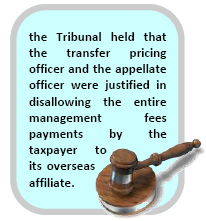|
|||||||||||||||
| Bangalore Tribunal upholds disallowance of management fees in the absence of commensurate benefits | |||||||||||||||
|
|||||||||||||||
Contentions of the Taxpayer before the Tribunal:
Ruling of the Tribunal:
Based on above, the Tribunal held that the transfer pricing officer and the appellate officer were justified in disallowing the entire management fees payments by the taxpayer to its overseas affiliate. Our Comments: In one of our earlier tax alerts last year, we had highlighted the increasing occurrences of disallowances being made in cases involving payment of management fees by Indian taxpayers to overseas affiliates. In cases involving payment of management fees to overseas affiliates, it is imperative to maintain robust documentation justifying the services rendered by the overseas affiliate, benefits received by the Indian entity, and the arm’s length nature of the charge. It is also pertinent to note that broad and vague explanations relating to the management services rendered by the overseas affiliates and benefit received by the Indian taxpayer etc. would not stand the test of audit by the Indian authorities, who insist on specific instances of services rendered and benefits received with respect to management fees, along with detailed calculation of amounts charged to the Indian entity and justification of arm’s length nature of amounts charged. As regards justification of services rendered and benefits received, while there is no straight-jacket formula laid down for the best possible documentation, a strong documentation would essentially be contemporaneous documentation which is maintained at the time of actual receipt of services. The documentation would include several internal records and documentation like notes, memos, e-mail exchanges, reports, processes documents etc. Further, the quality as well as adequacy of documentation should be reviewed at regular intervals; in addition to the final review and sign-off at the year end. If such contemporaneous documentation is maintained by the taxpayer, even if there is a disallowance made by the lower level tax authorities, there is a very strong case for allowing the management fee payments before the higher (appellate) authorities. |
|||||||||||||||
| Notes: | |||||||||||||||
| 1 - Gemplus India Pvt. Ltd. vs ACIT Circle 11(4), Bangalore. ITA No. 352 / Bang / 09 |
|||||||||||||||
|


 Contentions of the Tax Authorities before the Tribunal:
Contentions of the Tax Authorities before the Tribunal: